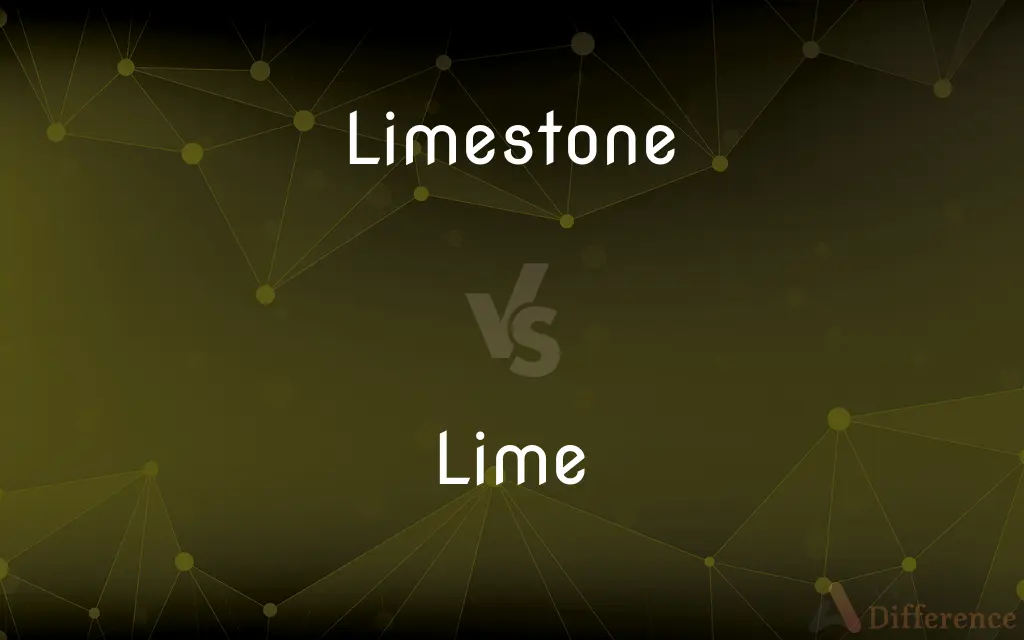Limestone vs. Lime — What's the Difference?
By Maham Liaqat & Fiza Rafique — Updated on March 11, 2024
Limestone is a naturally occurring sedimentary rock, rich in calcium carbonate, while lime is derived from the heating and chemical transformation of limestone.

Difference Between Limestone and Lime
Table of Contents
ADVERTISEMENT
Key Differences
Limestone is a sedimentary rock primarily composed of calcium carbonate (CaCO3), often formed from the remains of marine organisms. It is used in building materials and as a raw material in various industrial processes. Whereas, lime, often referred to as quicklime or hydrated lime, is produced by heating limestone in a kiln to release carbon dioxide, leaving behind calcium oxide (quicklime) which can then be processed into hydrated lime by adding water.
Limestone serves as a crucial component in the construction industry, providing base materials for roads and as a key ingredient in cement, while lime is extensively used in the steel manufacturing industry to remove impurities. Lime is also pivotal in water treatment, agriculture for soil pH adjustment, and in the production of paper and plastics.
The processing of limestone to produce lime involves high temperatures, typically between 900°C and 1,000°C, which facilitates the release of CO2 and transforms calcium carbonate into calcium oxide. On the other hand, the production of hydrated lime involves adding water to quicklime, initiating a chemical reaction that produces heat and results in calcium hydroxide.
Limestone's utility spans a broad spectrum, from architectural applications, such as in the construction of landmarks and buildings, to its use in manufacturing glass and cement. Lime, however, is indispensable in environmental applications, including water and wastewater treatment, where it helps to purify and adjust pH levels, and in agriculture, where it enriches soil with calcium and magnesium.
Limestone, with its natural beauty, is also carved into statues, decorative items, and is used in landscaping. Lime's chemical properties make it a key ingredient in mortar and plaster, providing durability and strength to construction materials.
ADVERTISEMENT
Comparison Chart
Composition
Primarily calcium carbonate (CaCO3).
Calcium oxide (quicklime) or calcium hydroxide (hydrated lime).
Source
Naturally occurring sedimentary rock.
Produced by heating limestone.
Industrial Use
Construction material, cement production, glass making.
Steel manufacturing, water treatment, agriculture.
Chemical Process
Formation involves sedimentation and compaction of marine organisms.
Involves heating (calcining) limestone and adding water (for hydrated lime).
Applications
Building material, decorative stone, manufacturing of various goods.
Environmental cleanup, soil pH adjustment, construction material.
Compare with Definitions
Limestone
A sedimentary rock composed mainly of calcium carbonate.
The White Cliffs of Dover are a famous example of limestone.
Lime
A chemical derived from limestone.
Lime is used in the treatment of wastewater to reduce acidity.
Limestone
Used in construction and architecture.
Limestone blocks were used to build ancient Egyptian pyramids.
Lime
An ingredient in construction materials.
Lime is mixed with sand and water to make mortar for bricklaying.
Limestone
Acts as a soil conditioner in agriculture.
Farmers apply limestone to neutralize acidic soils.
Lime
Used in the steel industry to remove impurities.
Lime is added to the blast furnace to bind with impurities and form slag.
Limestone
Used in the manufacture of glass.
Limestone, sand, and soda ash are melted together to make glass.
Lime
Essential for soil pH management in agriculture.
Lime is spread over farm fields to adjust the pH balance.
Limestone
A key ingredient in cement making.
Limestone is ground and mixed with other materials to produce cement.
Lime
Plays a role in water purification processes.
Lime helps to remove impurities from drinking water.
Limestone
Limestone is a common type of carbonate sedimentary rock. It is composed mostly of the minerals calcite and aragonite, which are different crystal forms of calcium carbonate (CaCO3).
Lime
A white caustic alkaline substance consisting of calcium oxide, which is obtained by heating limestone and which combines with water with the production of much heat; quicklime.
Limestone
A common sedimentary rock consisting mostly of calcium carbonate, CaCO3, used as a building stone and in the manufacture of lime, carbon dioxide, and cement.
Lime
Birdlime.
Limestone
An abundant rock of marine and fresh-water sediments; primarily composed of calcite (CaCO3); it occurs in a variety of forms, both crystalline and amorphous.
Lime
A rounded citrus fruit similar to a lemon but greener, smaller, and with a distinctive acid flavour
Wedges of lime
Lime juice
Roughly chop two limes
Limestone
Pertaining to or made of limestone.
Lime
The evergreen citrus tree which produces limes, widely cultivated in warm climates.
Limestone
A rock consisting chiefly of calcium carbonate or carbonate of lime. It sometimes contains also magnesium carbonate, and is then called magnesian or dolomitic limestone. Crystalline limestone is called marble.
Lime
A bright light green colour like that of a lime
A lime-green bikini
Limestone
A sedimentary rock consisting mainly of calcium that was deposited by the remains of marine animals
Lime
A deciduous tree with heart-shaped leaves and fragrant yellowish blossom, native to north temperate regions. The pale timber is used for carving and inexpensive furniture.
Lime
An informal social gathering characterized by semi-ritualized talking.
Lime
Treat (soil or water) with lime to reduce acidity and improve fertility or oxygen levels
They were liming acidified lakes
Lime
Catch (a bird) with birdlime
The bird that hath been limed in a bush
Lime
Sit or stand around talking with others
Boys and girls were liming along the roadside as if they didn't have anything to do
Lime
Any of several evergreen trees or shrubs of the genus Citrus having edible green or greenish-yellow fruit, especially the Mexican lime and the Persian lime.
Lime
The fruit of any of these plants, having a pulpy interior and usually acid juice.
Lime
See linden.
Lime
See calcium oxide.
Lime
Any of various mineral and industrial forms of calcium oxide differing chiefly in water content and percentage of constituents such as magnesia, silica, alumina, and iron.
Lime
Birdlime.
Lime
To treat with lime.
Lime
To smear with birdlime.
Lime
To catch or snare with or as if with birdlime.
Lime
(chemistry) Any inorganic material containing calcium, usually calcium oxide (quicklime) or calcium hydroxide (slaked lime).
Lime
(poetic) Any gluey or adhesive substance; something which traps or captures someone; sometimes a synonym for birdlime.
Lime
(theatre) A spotlight.
Lime
A deciduous tree of the genus Tilia, especially Tilia × europaea; the linden tree.
Lime
The wood of this tree.
Lime
Any of several green citrus fruit, somewhat smaller and sharper-tasting than a lemon.
Lime
Any of the trees that bear limes, especially Key lime, Citrus aurantiifolia.
Lime
(uncountable) A brilliant, sometimes yellowish, green colour associated with the fruits of a lime tree.
Lime
A casual gathering to socialize.
Lime
(transitive) To treat with calcium hydroxide or calcium oxide (lime).
Lime
(transitive) To smear with birdlime.
Lime
(rare) To ensnare, catch, entrap.
Lime
(transitive) To apply limewash.
Lime
To hang out/socialize in an informal, relaxed environment, especially with friends, for example at a party or on the beach.
Lime
Containing lime or lime juice.
Lime
Having the aroma or flavor of lime.
Lime
Lime-green.
Lime
A thong by which a dog is led; a leash.
Lime
The linden tree. See Linden.
Lime
The fruit of the Citrus aurantifolia, allied to the lemon, but greener in color; also, the tree which bears it.
Lime
The color of the lime{1}, a yellowish-green.
Lime
Birdlime.
Like the limeThat foolish birds are caught with.
Lime
Oxide of calcium, CaO; the white or gray, caustic substance, usually called quicklime, obtained by calcining limestone or shells, the heat driving off carbon dioxide and leaving lime. It develops great heat when treated with water, forming slaked lime, and is an essential ingredient of cement, plastering, mortar, etc.
Lime
To smear with a viscous substance, as birdlime.
These twigs, in time, will come to be limed.
Lime
To entangle; to insnare.
We had limed ourselvesWith open eyes, and we must take the chance.
Lime
To treat with lime, or oxide or hydrate of calcium; to manure with lime; as, to lime hides for removing the hair; to lime sails in order to whiten them; to lime the lawn to decrease acidity of the soil.
Land may be improved by draining, marling, and liming.
Lime
To cement.
Lime
Having a yellowish-green color like that of the lime (the fruit).
Lime
A caustic substance produced by heating limestone
Lime
A white crystalline oxide used in the production of calcium hydroxide
Lime
A sticky adhesive that is smeared on small branches to capture small birds
Lime
Any of various related trees bearing limes
Lime
Any of various deciduous trees of the genus Tilia with heart-shaped leaves and drooping cymose clusters of yellowish often fragrant flowers; several yield valuable timber
Lime
The green acidic fruit of any of various lime trees
Lime
Spread birdlime on branches to catch birds
Lime
Cover with lime so as to induce growth;
Lime the lawn
Common Curiosities
How is lime produced from limestone?
Lime is produced by heating limestone to a high temperature to remove carbon dioxide, resulting in calcium oxide (quicklime).
What is the temperature required to produce lime?
Temperatures between 900°C and 1,000°C are required to produce lime from limestone.
Is lime environmentally friendly?
Lime has environmentally beneficial uses, such as water treatment and soil restoration, but its production does emit CO2.
Is limestone used in water treatment?
Limestone can be used in certain water treatment processes, but lime is more commonly used for adjusting water pH and removing impurities.
What are the main differences between limestone and lime?
The main differences lie in their chemical composition and usage: limestone is a natural rock, while lime is a chemical product derived from limestone.
Can limestone be used as a building material?
Yes, limestone has been used as a building material for centuries due to its durability and aesthetic appeal.
What is limestone made of?
Limestone is primarily made of calcium carbonate (CaCO3).
Can lime be used in agriculture?
Yes, lime is widely used in agriculture to adjust soil pH levels.
Can lime be used in food?
Yes, food-grade lime is used in some food preparation processes, such as pickling and corn nixtamalization.
What are the uses of hydrated lime?
Hydrated lime is used in soil stabilization, water purification, and as a building material in mortar and plaster.
Why is lime added to soil?
Lime is added to soil to increase pH levels and improve soil quality for plant growth.
How does lime help in water treatment?
Lime helps in water treatment by adjusting pH levels and precipitating impurities.
What is the role of limestone in cement production?
Limestone is a key ingredient in cement production, providing the calcium carbonate needed in the cement mixture.
How are limestone and lime similar?
Both originate from limestone, but lime is a product of limestone's chemical transformation.
Is hydrated lime the same as quicklime?
No, hydrated lime is produced by adding water to quicklime, resulting in calcium hydroxide.
Share Your Discovery

Previous Comparison
Neuroscience vs. Neurology
Next Comparison
Peace vs. ReposeAuthor Spotlight
Written by
Maham LiaqatCo-written by
Fiza RafiqueFiza Rafique is a skilled content writer at AskDifference.com, where she meticulously refines and enhances written pieces. Drawing from her vast editorial expertise, Fiza ensures clarity, accuracy, and precision in every article. Passionate about language, she continually seeks to elevate the quality of content for readers worldwide.














































